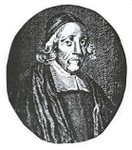Mitchell on Adams 05
This is the last section from W Fraser Mitchell.
A careful consideration of such of his sermons as are dated unfortunately demolishes Professor Croll’s contention that Adams began in imitation of Latimer and the medieval preachers, as did Jewel and Lever before him, but that he gradually shook himself free from the fascination of their gay ornaments and rhetorical schemata. Taken, so far as is possible, in chronological order, Adams’ work reveals no sign of such development, but all through his life he continued to employ the favourite schemata of preachers in all ages from the time of Cyprian onwards - particularly paramoion - with greater or less elaborateness in proportion as he was striving after rhetorical effects. It is true that Adams seems to us to achieve his happiest effects when he leaves the schemata alone and takes flight on the gauzy wings which were afterwards to bear Jeremy Taylor into the blue of heaven in pursuit of his lark (see note), or reminds us, reminiscently it is true, but with something of Fuller’s wit, of our natural swarthiness and the repeated tanning of our sins. (Englands Sicknesse, ed cit, p 306). But this is only to acknowledge that we prefer Taylor’s poetical fancy or Fuller’s wit to Lyly’s parallelism, and consequently are more ready to appreciate Adams where he most resembles the later writers. The men of his own day no doubt thought otherwise, and were ready to applaud his balanced clauses, where adjective corresponded to adjective, noun to noun, and a similarity of ending or resemblance in sound was sedulously cultivated. Professor Croll’s assertion that such figures — the last faint echo of classical rhetorical training enjoyed a florescence in England among the celebrated of the older preachers at the opening of the seventeenth century is amply justified; but that florescence enjoyed a sudden metamorphosis under the influence of Bacon and Donne in the actual sermons of Adams seems hardly tenable. Adams is rather to be regarded as a fellow-worker with these greater writers, breaking down the tyranny of the schematic patterns in the interests of a less pointed, more sonorous style. As early as 1614 we find him able to dispense with the wearisome second half of his antitheses, and close like Bacon with a statement, giving a quiet ending without the customary reverberation. Space alone precludes quotation of some of the longer and more matured passages which obviously what attracted Southey’s admiration; yet the fact remains that in sermons of a late date the older, cruder use of the schemata recurs, which is to be explained neither as a reversion on the part of Adams, nor, as with Williams' ‘Six Sermons,’ preached in the 1640s, in terms of Dryden’s gibe about stylistic abuses finding benefit of clergy, but simply points to the extraordinary experimentation that was then taking place among English writers — an experimentation in which the pulpit, as represented by Adams and men of his type, took a prominent part. The preacher, like the poet, is both moulded by his age and exerts an influence upon it, and the sermons of Adams present us with the case of a man catering at times for popular vogue, but who in his published work was undoubtedly preparing the way among his readers for other and less jejune stylistic effects.
Note
‘The Fatall Banket,’ ed cit, p 220: the passage opening: "As inafaire Summers morning when the Larke bath called up the Sunne, and the Sunne the Husbandman: when the earth bath opened her Shop of perfumes, and a pleasant wind fannes coolenesse through the ayre; when every creature is reioyced at the heart; On a suddaine, &c" is one of the finest in the whole range of Adams’ writings.







No comments:
Post a Comment